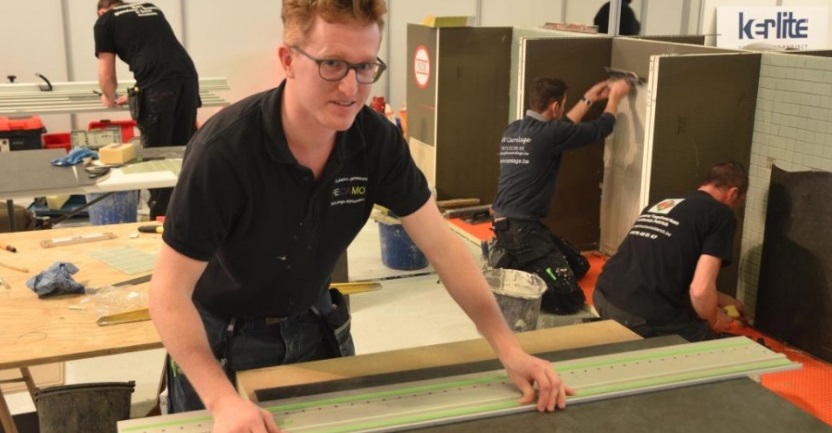Tom Verstaen crowns himself Belgian champion in tile setting
By Staenis | 20/01/2017
The successor of James De Smet, who was named Belgian Champion of Tiling in 2015, is known! His name? Tom Verstaen. The 25-year-old East Fleming received the highest score from a professional jury for the tiling work he completed on the exhibition floor of Stone & Tile 2017 in Ghent in two days.
Young tiling champion emerges as ambitious entrepreneur
And whether Tom Verstaen was nervous about his participation in the Belgian Tile Laying Championship in Ghent? So much so that the night before, he had a very hard time falling asleep! Initially, the 25-year-old from East Flanders thought that a silver medal was the highest he could achieve, but as the two-day competition progressed, Verstaen sensed his chance and (just) managed to take the gold. Anyone who wants to call on the brand new tile laying champion in the coming months is out of luck, because the busy bee from Olsene is currently hatching other plans…
Start-ups
If you want to see the Belgian tile-setting champion of 2017 live in action, you now have to go to Kortrijk. Not on some construction site, mind you, but behind a desk in a building where he operates under the wings of Start it @ KBC. Start it offers support to entrepreneurs to help them build their start-up. One of those entrepreneurs with an innovative idea is the same young man who, in mid-January at the recent Belgian Tile-Setting Championship during Stone & Tile 2017 in Ghent, took home the gold medal. The exact reason why Tom Verstaen ended up in the Start it @ KBC support program will be revealed shortly, but first, let's go back to the Belgian Tile-Setting Championship. By the way, it wasn't the first time Tom Verstaen participated, because during the previous edition in 2015, the twenty-something from Olsene, East Flanders, also tried his luck. If I remember correctly, I finished fourth back then. At that time, that was the best I could achieve, because the competition had much more experience than I did, as I only occasionally installed tiles.
Second time lucky?
Also during his second participation, Tom Verstaen did not really aim for the top spot. For me, Wim Verkinderen (who eventually won bronze; ed.) was the clear favorite. I believed the other candidates would compete for silver and bronze. When I was told that Thomas Standaert has twenty years of experience as a tiler and is also a teacher, I saw my chances of a podium finish seriously diminish.
At the end of the first day, however, confidence grew and Verstaen increasingly began to believe in his chances of winning his first Belgian title. I was very well prepared, had practiced hard at home on the part of the assignment that we were partially given in advance. The most difficult part was the wavy arch that we had to cut freehand from that thin Kerlite slab. Everyone was quite afraid of breaking it. The challenge was also in making the glass mosaics fit together nicely. According to the jury, my arch was perfectly symmetrical and that execution may have earned me the title. In any case, it was very close, with barely one point ahead of Thomas Standaert, who scored better in the freestyle exercise and was rightly rewarded with the creativity prize. Personally, I learned an incredible amount during those two days, and for that alone it was worth it.
Own business
Where did Tom Verstaen actually learn the tiling trade? After three years of training at Syntra West, I was completely hooked. Because I wanted to gain even more knowledge, I sent an email to Peter Goegebeur, who was my teacher in the final year. He literally took me everywhere: to the many workshops he gave all over the country, but also to the meetings of Fecamo and the WTCB. There, I got to know Tinne Vangheel from the WTCB and Veerle Boel from Ghent University; these people have also helped me tremendously.
The man sitting in front of us turns out to be a jack of all trades. After studying automotive mechanics and welding at the VTI in Deinze, Tom Verstaen also took evening courses at Syntra West in electricity, plumbing, plastering, painting, and tiling. I am someone who likes to take on new challenges. The advantage is that this allows me to do most things myself, such as renovating a bathroom from A to Z. I often did this together with my father, who is also active in construction as a self-employed worker (Karweidienst Bart Verstaen; ed.). Because I wanted to start my own business, I was forced to stop doing that last year.
The StaenisGrid
The founding of their own company, called Staenis, was preceded by a surprising invention. Tom Verstaen tells the story. The idea arose last year after a bad experience I had during the installation of a screed floor. It turned out to be anything but level when I was laying the tiles. To correct this, I had to lay some of them in mortar instead of gluing them, with the result that the client—quite rightly—was upset about how long the tiling was taking. That evening, I spent the whole time at home pondering and came up with a system to very easily install a perfectly level screed: the Staenis grid. The TETRA project on 'insulated interior floors' from Ghent University showed that there is no uniform solution to prevent curling in screed floors. Every construction site has different environmental factors that can have an influence, and for that reason, different installation guidelines apply. The Staenis grid offers the solution for a perfectly level screed floor in many circumstances!
Many advantages
Placing such a grid in the floor structure is very simple, the inventor assures. After it is quickly set to the correct height, you can place the screed in it, creating fixed reference points on which you can level off. The StaenisGrid divides the surface into squares of 0.25m², resulting in minimal stresses. As a result, the screed will only minimally warp or bulge. There is also the option to place the grid flat or at a slope.
Recycled plastic without fiberglass was chosen as the material, which has the advantage that you no longer have the problem of reinforcement meshes disintegrating in the cement screed. Another thing: a fast-drying screed starts to harden after a short time. With our grid, that's not a problem, because it allows for very quick work. After placing the grid, you can have the screed installed in a bathroom in just fifteen minutes. The first reactions from the market are therefore very promising, says Verstaen. It's logical when you consider that our system enables a traditional screed that is ten times flatter than normal and remains just as even afterwards.
Confidentiality
A week after his inspiration, the inventor of the StaenisGrid conducted a first test. The result was astonishing; I had never installed such a level screed before!
When it turned out that no such system existed on the market, the young man from East Flanders knew what he had to do: apply for a patent to protect his invention as quickly as possible. In the end, I spent several months getting everything arranged. That was not a pleasant period, as I was so eager to share my secret with others, but at that time I had to keep my lips tightly sealed. The first person I confided in was Peter Goegebeur, and he responded very enthusiastically. Once the patent was in order, I was able to talk to other parties to look for possible improvements. This way, I make new discoveries every week.
International ambitions
Once all components have been produced, we will install test floors with different thicknesses and have them tested at Ghent University. We will also install test floors with underfloor heating, on which tiles ranging from 30x30cm to 100x100cm will be glued to verify that everything functions properly.
Assuming that this innovation catches on in Belgium, can its success also be replicated beyond the country's borders? That is indeed the ambition, Tom Verstaen makes no secret of it. That is why we immediately applied for an international patent. Initially, we will focus 100% on the Belgian market, but afterwards we also want to take our product abroad. Why not? After all, this system can provide the perfect solution to many problems. The plan is to make this the new standard, in order to easily surpass even the strictest guidelines of the WTCB.
Through Bert Uittenhove and Peter Goegebeur, we came into contact with BITA, Belgian Innovative Tile Academy. At the request of BITA, the Belgian Innovative Tile Academy, we will provide training to tilers and screeders who want to learn how to work with our system.
Online sales
We have learned that the first units will come onto the market later this year. In a few months, the mold should be ready, with production starting two to three months thereafter. It is already certain that we are choosing a Belgian manufacturer.
The plan is to offer the grids only through a webshop and to have them delivered from a single central stock to the customer's home or construction site, just as Coolblue or bol.com have been doing for years. In this way, we also want to innovate in the construction industry in terms of logistics.
For clarity: Tom Verstaen is not doing this alone. There is actually a second person who has also put her shoulder to this innovation project. Daisy Bohyn, a good friend he has known since primary school, is an interior architect by training and later also obtained a degree in product design. She is my ideal business partner.
Bright future
There will no longer be time in the coming weeks and months to showcase my skills as the Belgian tiling champion. At the moment, this project is already taking up all my time; I am truly working on it day and night. And for now, it doesn't look like that will change anytime soon. Of course, it's a shame that I will probably be much less active as a tiler. Nevertheless, I want to continue to contribute to the tiling world. In Belgium, there is still some work to be done to elevate the craft of tiling. That is why I am especially happy with this new project. Daisy and I know where we want to be in three years, and after that, we will see. Failing is not an option anyway; we believe too strongly in the product for that. As young entrepreneurs, this is obviously a challenge that also brings risks, but we firmly believe that we are going to write a success story with this product. Wait and see!
If you want to stay informed about their innovative product, you can visit www.staenis.com.
Podium finishes
For the second edition in a row, the biennial Belgian championships, organized by Fecamo, were held during and at the Stone & Tile trade fair in Flanders Expo Ghent. Younger and slightly more experienced tilers, eight participants in total, competed for two days (on January 19 and 20, 2017) for the coveted title. In the end, it was 25-year-old East Fleming Tom Verstaen, previously tipped as one of the favorites, who received the highest overall score from the jury members. Thomas Standaert finished in second place and was rewarded with the prize for creativity. Wim Verkinderen completed the podium with a bronze medal. The Walloon 'youngster' Quentin Magnier finished as the top junior-student in a respectable fifth place.








